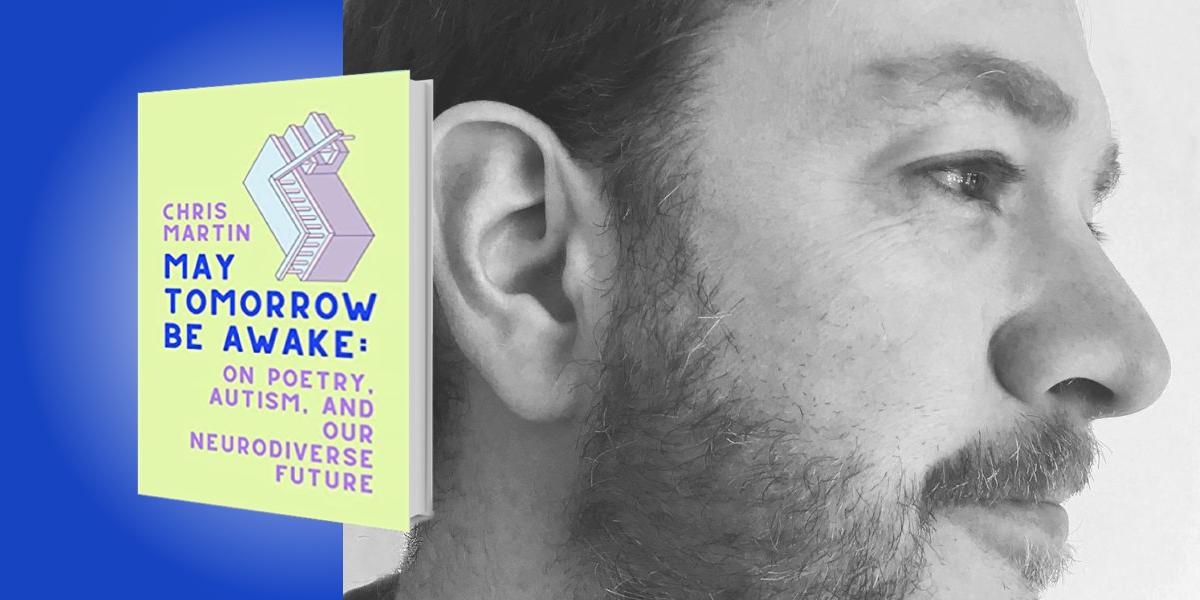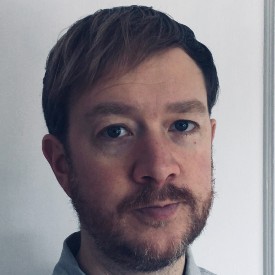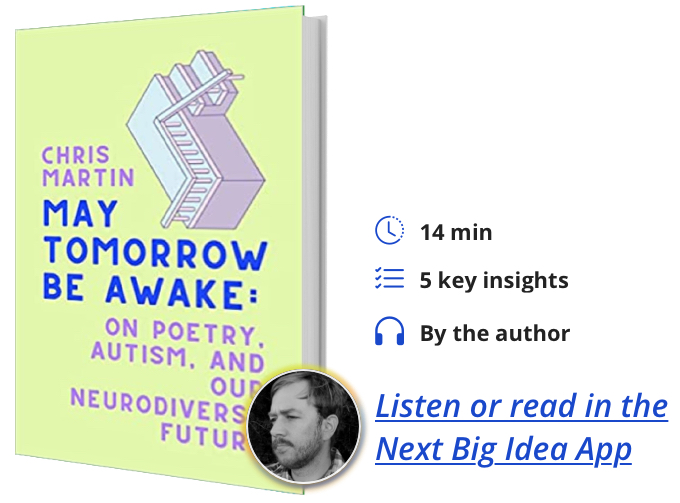Chris Martin is a neurodivergent, award-winning poet, and celebrated educator who teaches non-verbal children and adults on the spectrum to find their voices through poetry.
Below, Chris shares 5 key insights from his new book, May Tomorrow Be Awake: On Poetry, Autism, and Our Neurodiverse Future. Listen to the audio version—read by Chris himself—in the Next Big Idea App.
1. Find a place where the islands touch.
One of the things you’ll hear from educators when they are struggling to integrate the vibrant intelligence of autistic students is that sometimes these students have a passion that seems to obscure everything else. In diagnostic literature, this is called a restricted interest, defined as an obsession with abnormal intensity. As a poet and as someone who’s very passionate, I immediately recognize those passions as areas of devoted study. What I have found while working with these students is that we need to revel in those passions first before we move to adjacent territory.
Oftentimes, it can seem like an autistic student is on their own island. When I started out as a teacher I had a student named Brian, whose island was mammals. He was so excited about mammals. The first time we met was at the Museum of Natural History, and he was buzzing from diorama to diorama, talking directly to the animals, and reeling off facts about them. I was supposed to teach him English, but Brian refused to talk about anything made up or related to people. Teaching English was going to be a challenge, so I asked myself, “How can we begin in a place Brian loves and then navigate towards adjacent territory together?”
“What I have found while working with [autistic] students is that we need to revel in those passions first before we move to adjacent territory.”
We began with a CGI video series called Walking with Prehistoric Beasts. These prehistoric beasts are mammals that existed sixty million years after the dinosaur extinction and before the arrival of homo sapiens. We’d talk at the end of each episode as if it were a story, thinking about which mammals were protagonists and antagonists. We’d bring in the language of English without thinking about things as made up or not. These things, in a sense, were made up because they’re retrospective speculative science, but they were also true because they’re based in fact. In the last episode of the show, homo sapiens arrived. After that final episode, Brian was somewhat begrudgingly willing to admit that humans were mammals too, which was not something he would previously admit.
As we learned, we moved adjacently and expanded the territory into which Brian felt passion and was interested in studying. Then, a couple of years later, we progressed to reading A Wrinkle in Time and a couple of years later, we advanced to Roman history. Brian has now gone on to graduate from college and lives in New York. He’s a brilliant human, and while he would have been all along, I was glad that I was able to take part in his journey.
2. Explore natural learning through the “Wanting Way.”
My student Adam also taught me a lot about autistic joy and about following those passions. He has taught me to specifically follow those passions in ways that allow for other kinds of expressivity. Adam calls himself the Masterful Tic-er and his body is full of expressive tics and stims that surface throughout our sessions working together, which are welcomed and celebrated. Until working with him, I hadn’t realized how important it was for people to be able to fully show up in their bodies and move in the ways that felt good to them while learning.
“Until working with him, I hadn’t realized how important it was for people to be able to fully show up in their bodies and move in the ways that felt good to them while learning.”
The Wanting Way is like a path and, as my friend, Sid Gauche once wrote, “I am not smarter than others. I am simply privy to a new road.” This gets to the idea of our neurodiverse future, that we can find new ways to get to the lives we want to live. For many autistic people, these lives are deeply patterned and sensory-rich. Therein lies the reciprocity with poetry, as poetry is all about pattern and sensory detail. Poetry, as the Wanting Way, comes naturally to many autistic writers.
3. Open up to the “Listening World.”
When autistic writers take up poetry, they’re able to give us poems that help us enter a world of greater attention and abundance, also called “The Listening World.” Hannah Emerson wrote a poem called “The Listening World” in the second session that we ever had together. She had been doing a little bit of writing beforehand, but this poem was a big leap for her, and it was a life-changing leap for me to read. It is one of the only perfect poems I have had the pleasure to read:
Say a prayer for little things, things that live in deep hurt. Feelings, language take to lair.
Let it signal nothing’s light, I say for want of light feelings. Is my ear deep or deeper?
Hannah invites us into this layer of expressivity and listening where the more-than-human world is crying out to be recognized. There isn’t a more important or relevant question at this time for our species. Are our ears deep or deeper? Are we able to reconnect to the more-than-human world in a way that can sway us back towards sustainability, towards the valuing of our land and our animal and plant relatives? The thinking of autistic writers is going to be a crucial resource for allowing us to do that.
4. Embrace tilted thinking and avoid troubled-abled thinking.
These two terms come from my friend Amman Bukela, who first introduced the idea of tilted thinking in a poem. All through my teaching career, my various students had been pushing me to embrace my own neurodivergence. Amman offered tilted thinking as a non-diagnostic term that could make our islands touch. It allowed for more connection in an already-rich relationship, as well as an affirmation as a self-identified tilted-thinker.
“Our ability to find connection despite our neurological differences is the most important practice in which we can collectively engage.”
The flip side of tilted thinking is what Amman refers to as troubled-abled thinkers. One can explore troubled-abled thinking by asking the following questions: What are the ways in which internalized ableism is troubling the way I move through the world and is troubling other people in the way they move through the world? What kinds of expectations am I conditioned to accept that are harmful to me and harmful to others? Thanks to Amman, these questions may help guide us into a neurodivergent revolution.
5. Look for ways to be other together.
Finally, we need to find ways of being other together. This idea comes from Amelia Bell, a non-speaking autistic writer. Amelia’s poem is centered on the idea of belonging. How do we find belonging together? How can we recognize our differences, our othernesses, and find that connecting across those differences holds us together in a way that is healing, transformative, points us towards forms of justice?
This process of questioning is something that comes up in a million different ways. Our ability to find connection despite our neurological differences is the most important practice in which we can collectively engage. By doing so, we will undoubtedly bring forth new insights that will lead to a richer life.
To listen to the audio version read by author Chris Martin, download the Next Big Idea App today:

































